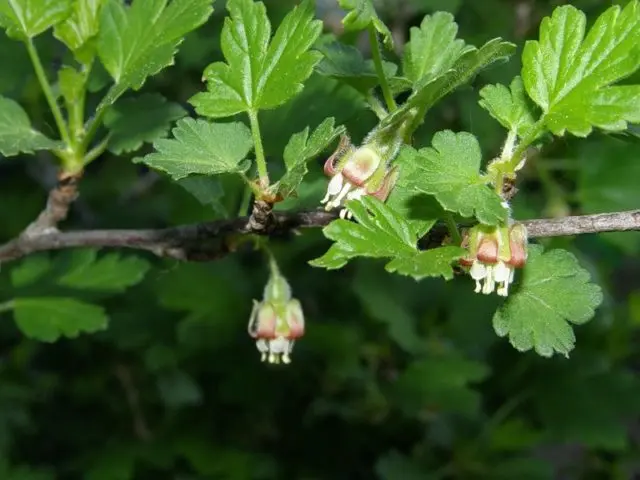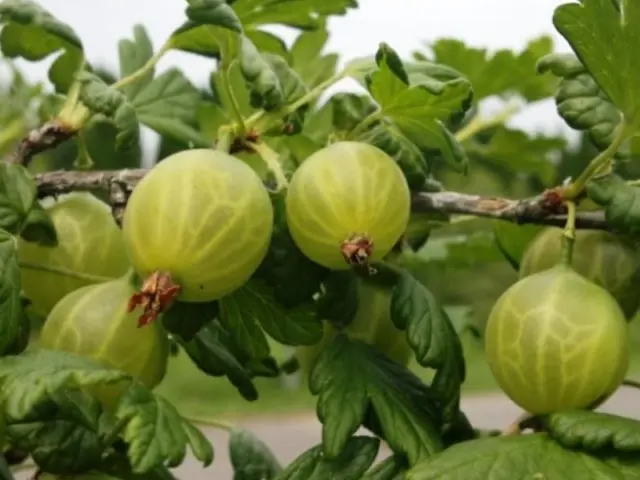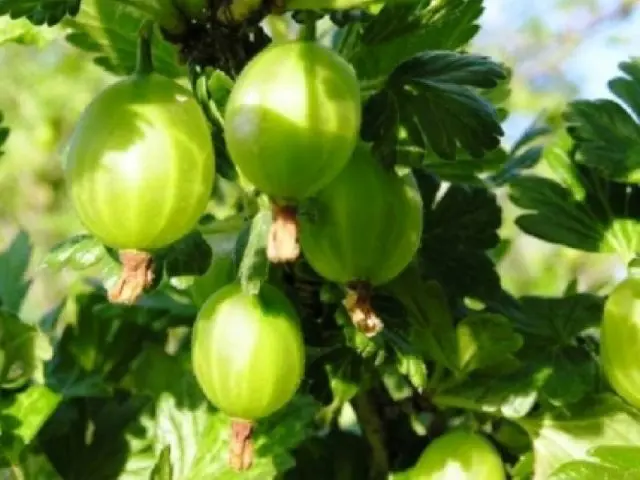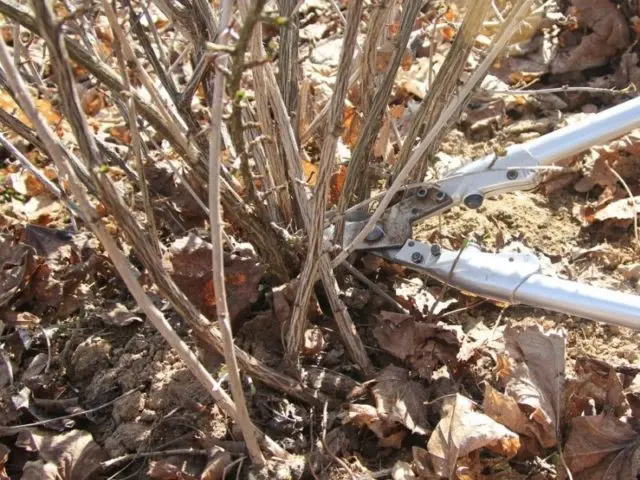Contents
Gooseberry thornless Ural has excellent taste qualities. It is widely distributed in the northern regions due to its frost resistance and unpretentiousness. This culture has its drawbacks, but they are offset by many advantages.
History of variety breeding
The gooseberry variety Ural thornless was obtained at the Yuzhnouralsk Research Institute of Horticulture and Potato Growing by crossing the Ural Green and Slaboshipovaty-2. The author of the selection is Ilyin V.S.
Description of the gooseberry variety Ural thornless
The gooseberry bush of the Ural variety is thornless, vigorous, notable for its slight spreading and density. It can be grown in almost all climatic zones of Our Country, including the regions of Siberia. The branches are directed vertically, but side shoots can grow with a slight slope. The bark is yellow-gray in color. Annual branches are powerful, green, not pubescent. The kidneys are colored light brown. Spikes are absent or present, but in small quantities.
The leaves of the Ural thornless variety are three-lobed, the middle lobe is strongly pronounced. They have a glossy surface and a dark green color. The leaf plate is concave, wrinkled in structure, with light veins. Petiole about 2 cm in size, slightly pubescent.
The Ural thornless variety blooms in the second half of April or in the first days of May. The buds are painted in bright crimson. The flowers are pink but fade over time.

The gooseberry Ural thornless belongs to large-fruited varieties – the berries weigh 8–9 g each. They are oval in shape, bright green in color with a matte surface without pubescence. The fruits come off the branches easily. The skin is dense with a sour taste, the pulp inside is sweet and juicy. The veins are lighter than the color of the berry and therefore are clearly visible. Green stalk.
Characteristic of the variety
In the description of the gooseberry variety Ural thornless, there are mostly positive characteristics. It is endowed with properties that help withstand harsh climatic conditions and various diseases. At the same time, there are no inconveniences during harvesting.
Drought resistance, frost resistance
According to the description of the variety, the Ural thornless gooseberry has high frost resistance and tolerates drought well. Withstands temperatures down to -30 °C.
Yield and fruiting
Variety Ural thornless shows good yield. Young plants give 5 kg each, and bushes over 5 years old – 7–9 kg. Gooseberries have the highest rates at 6–7 years.
Due to the sweet taste of berries, Ural thornless is classified as a dessert variety. It is characterized by an average ripening period, but the berries are harvested a little earlier, because they are prone to shedding.
Scope of fruits
The dessert taste of the Ural thornless fruit allows them to be used both fresh and for various preparations. Most often, jam is made from gooseberries. Since the berries are picked a little earlier, they tolerate transportation well and are able to be stored.
Ural thornless gooseberry is shown in the photo:

Disease and pest resistance
The gooseberry variety Ural thornless has resistance to septoria and powdery mildew. But the bush can be attacked by harmful insects.
Advantages and disadvantages of the variety
Advantages of the gooseberry variety Ural thornless:
- a large number of useful substances in berries;
- dessert taste;
- lack of spines;
- large fruits;
- resistance to diseases;
- frost resistance;
- high yield;
- drought resistance.
The main disadvantage of the Ural thornless variety is the significant shedding of berries, which requires harvesting to begin before they are fully ripe.
Gooseberry planting rules
When planting gooseberries, it is recommended to follow certain rules. This will allow the young plant to take root better and subsequently produce large yields. Failure to follow these rules can harm the gooseberry bush.
Recommended dates
Gooseberries of the Ural thornless variety are planted in the fall, which allows you to get a crop next year. Recommended dates are the end of September and the entire first half of October. It is also worth focusing on the onset of frost in a particular region, so that the gooseberries have time to take root and survive the winter normally. Some gardeners also practice spring planting, but then you need to be in time before bud break.
Choosing the right place
For planting choose a flat sunny area. Gooseberries can tolerate some shade. It must be ensured that groundwater does not pass near the surface of the earth in this place.

The gooseberry is undemanding to the soil, but it cannot be planted next to the paths, because the roots do not tolerate compaction. In Siberia, bushes are recommended to be planted where a greater snow cover is formed.
Selection and preparation of planting material
It is better to purchase gooseberry seedlings aged 1–2 years, having 3–4 shoots at least 20 cm long. The root system of the bush should be well developed.
It is recommended to plant gooseberries immediately after purchase. If this cannot be done, then it is better to carry out a number of preparatory measures:
- the roots are wrapped with a damp cloth and placed in a bag;
- if transportation is needed, then the seedling is given a strictly vertical position;
- to avoid drying the roots, they must be dipped in a clay mixture or sprinkled with wet sawdust;
- immediately before planting in the ground, it is necessary to remove the leaves, damaged and dry parts of the roots, and also shorten the shoots to 20 cm.
Landing algorithm
The site for planting is prepared in advance – 2 months in advance. If the soil is loamy, then sand is added. The landing algorithm is as follows:
- Dig a hole measuring 50×70 cm, while laying the top layer of fertile soil and the lower layers in different directions. If planting is carried out on black soil, then the dimensions can be reduced to 40×40. Manure, humus, potash salt have yet to be introduced into the less fertile land.
- Wood chips are placed at the bottom of the pit, which will serve as drainage and pour water in the amount of one bucket.
- If there are several bushes, then a distance of at least 1 m is maintained between them, because the feeding area of the gooseberry root system is 2 sq. m.
- Around the bush form a circle for watering. A day later, the soil is mulched with peat or sawdust.
Follow-up care for gooseberries
Fertilization is not required in the first year after planting. In the second year, organic feeding is necessary. In the third year, wood ash and superphosphate are used. Further, gooseberries should be fed every 2-3 years.

The plant requires the following care measures:
- watering;
- weed removal;
- loosening;
- top dressing;
- treatment for pests and diseases;
- pruning;
- mulching.
When watering under a bush, it is enough to pour a bucket of water as the soil dries up and then if the plant has recently been planted.
The next year after planting the bush, pruning is carried out. Thus, the yield of the plant can be increased. First, zero shoots are removed, leaving 5–6 of the strongest. The bush should have branches of different ages, with the exception of those that are more than 7 years old. Old and diseased parts of the plant must be removed. Anti-aging pruning is carried out when the culture reaches 10 years.

In Siberia, gooseberries must be covered for the winter, bending the branches to the ground. In warmer climates, it will survive the cold without problems.
Diseases and pests, methods of control and prevention
The gooseberry variety Ural thornless has a strong immunity to most diseases, but can be attacked by pests. Preventive measures are carried out twice a season – in spring and autumn.
There are many pest control products on the market, but experienced gardeners advise using folk methods as well. It will be effective in early April to quickly pour water over the bush heated to a temperature of +80 ° C. After this procedure, all debris from under the bush should be collected and burned.
At the beginning of budding, gooseberries should be sprayed with Rovikurt. This will protect the bush from aphids, gall midges and sawflies. A solution of colloidal sulfur will be effective against pests that damage the buds.
In autumn, gooseberry bushes are sanitized without fail. Sick and damaged leaves and shoots are removed. The plant itself and the ground around it must be treated with nitrofen, then watered abundantly and mulched with a thick layer of peat.
Conclusion
Gooseberry thornless Ural unpretentious culture, suitable for almost all climatic zones of our country. The dessert taste of the fruit allows it to be used not only for preparations, but also fresh. Large fruits and the absence of thorns are one of the qualities due to which the Ural thornless gooseberry retains its popularity and collects positive feedback from gardeners.










Բարև Ձեզ, ինչպե՞ս և որտեղի՞ց կարելի է գնել փշահաղարջի (крыжовник) տնկիներ։ Խնդրում եմ զանգահարել’ 055020388
Նախապես շնորհակալություն։